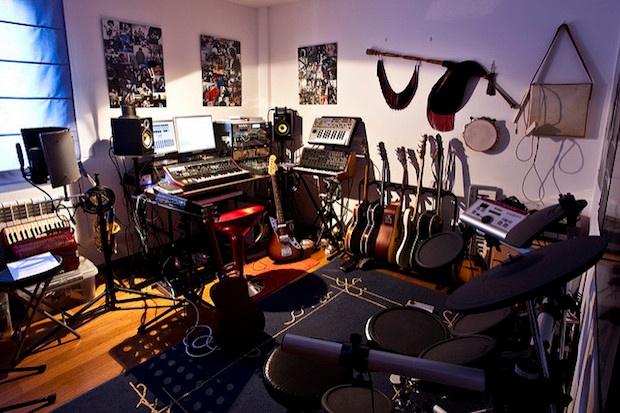 Image by Feans via Flickr / CC BY 2.0
Image by Feans via Flickr / CC BY 2.0
Guest post by producer, sound engineer and composer Filippo Gaetani. Filippo is the founder/CEO of the Recording Festival, which gives artists the opportunity to record for free in the same studios as Michael Jackson, Muse and Bonnie Raitt.
After listening to countless young artists’ demos and tracks from home studios, I’ve noticed a few common (and often, easily fixable) mistakes that seem to keep popping up.
Assuming that you have a good song to start with, the biggest problem is that most of today’s bands start the recording process without having a solid vision for the production. The way you capture a sound or instrument is a part of the production, which means that the way you set up and use your mics will have a huge impact on the rest of the production process.
Maybe you want to take a minimalistic approach like Led Zeppelin or James Brown, or maybe you’d rather emulate the full-blown drum mic’ing of Dave Matthews Band or Porcupine Tree. Perhaps the pristine, beautiful, dry guitar mic’ing of old AC/DC tracks are what get you, or maybe you love the chemical drum and synth sounds created by producers like Trevor Horn. In every single one of these cases, there was a vision, a sound in mind, before the record button was ever pressed.
You can’t expect to have a good mix if you don’t have a good recording, so here are the five most common mic'ing mistakes to watch out for when you record your next song:
1. Placing the microphone in a way that doesn’t maximize the fullness of the sound
The distance of the mic from the source affects the recording quality and sound character, so don’t be afraid to experiment. Use your gifted musician ears and listen. Sometimes one inch makes a huge difference. Place yourself around the source and be creative about how to achieve the fullest sound.
Be careful with your settings – check your levels and distortion. Once it's printed, it’ll be enormously difficult to recreate the magic of the performance. If you’re recording lead vocals, the most common practice today is to sing very close to the mic and make use of a pop filter to tame the rumbling letters P and T.
2. Using the wrong microphone for the task
Mics, just like instruments, have a character and deliver it clearly when the sound is printed. It takes many years of recording to learn the industry standards and discover what works best for you, so take some time to experiment. Unless you already know your tools, try at least two or three different mics before committing to a decision.
In many cases, you won’t even need an expensive mic – you just need the right mic. Check out this list of the 10 best affordable microphones for the home studio to start exploring your options. For your reference, I’ve also included a brief list at the end of this article of some of the most popular mics and how they’re commonly used in the studio.
3. Not checking the phase coherence with other microphones
Boring stuff, but super important. Basically, phase incoherence might take place when two mics capturing the same source are not placed at the same distance. It results in a sound cancellation when the levels are brought to equal volume… which essentially just means that it’ll cause a crappy sound. Try your best do avoid this, but if you can't (sometimes you can't sacrifice creativity for tech purposes), make sure to switch the phase of one or more during mixdown. Take notes on these things while you’re recording, and check them when you’re mixing. If you want to learn more about phase, we’d recommend reading this article from Home Studio Corner.
4. Not using the best signal-to-noise ratio (don’t hit the red zone!)
Check the signal coming from the mic to the preamp, drive accordingly to your taste (but not too low), and keep the preamp output low, because recording in 24-bit doesn't require high signals into the DAW. In the DAW, barely hit the yellow, and never the red. Feel free to hit the preamp hot with the input gain if it’s a good one – it has headroom to play with!
5. Using low-quality preamps and cables
Mic preamplifiers and cables are just as important as the mic itself. Don’t believe cables make a difference? Try recording with an old cable of yours, and then go buy a pro cable like a VoVox, Mogami or Monster and compare the difference. You’ll be floored.
Don’t be cheap when it comes to cables – make a small investment that will last a long time. If you can't afford famous preamps like a Neve or API, borrow one from a friend or rent one. Don't rely on the local DAW interface preamp.
When it comes down to it, analog gear lasts much longer than a cool plugin or software that will soon be replaced by something with a fancier user interface. Software can be fleeting, but handmade gear designed by great people and companies endures.
___
Here are a few examples of how popular mics are commonly used to help you get started:
Modern condenser mics
- AKG 414: vocals, acoustic guitar, percussion, piano, drum overheads, room ambience, cello
- Neumann KM 184: piano, acoustic guitar, drum overheads
- Neumann TLM 103: vocals, acoustic guitar, strings
- Audio Technica AT2020: vocals, acoustic guitar, strings
- Rode Classic MK1: vocals, acoustic guitar
Modern dynamic mics
- Shure SM57: vocals, guitar amp, snare drum
- Electro Voice RE20: bass amp, kick drum, vocals
- Shure SM7: vocals, guitar amp
- Beyer 380: kick drum, bass amplifier
- AKG 112: kick drum, bass amplifier
- Sennheiser 906: guitar amp
- Sennheiser 421: rack toms, guitar amp
- Sennheiser 441: saxophone, vocals
Best vintage mics (very expensive)
- Neumann U47: vocals, ac guitar, string instruments, double bass
- Neumann U67: vocals, saxophone
- Neumann KM84: ac guitar, piano, drum overheads
- AKG C12: Cello, female vocals, room ambience (stereo version C24: piano)
- Telefunken 251: female vocals
Modern ribbon mics (deliver a warm and vintage sound)
All of these can potentially be used for vocals, acoustic guitar, drum overheads, guitar amps and wind instruments, depending on the sound you want to achieve.
- Coles 4038
- SE RNR1
- Royer 121
- Beyer M160
- AEA R84







